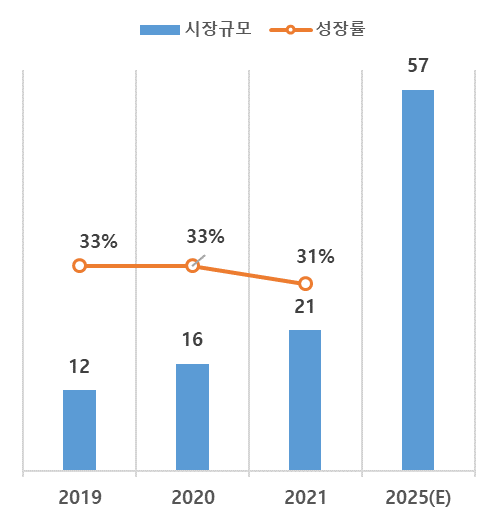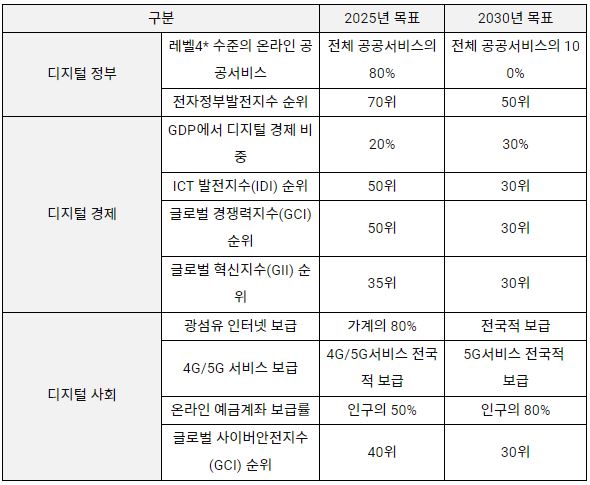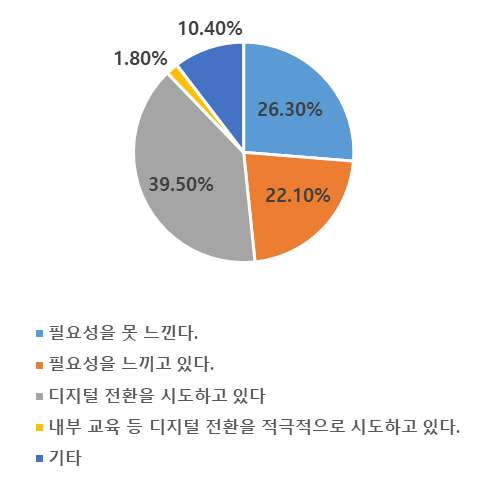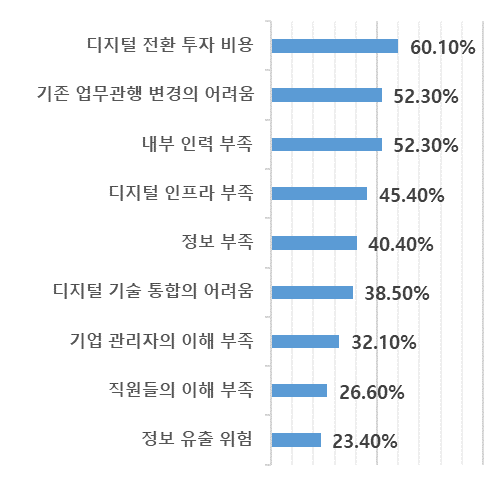– Vietnamese people use the internet for an average of 6 hours a day, digital transformation begins in earnest
– Expansion of related advancement opportunities by accelerating digital transformation
As the use of non-face-to-face digital platforms (e-commerce, online delivery, etc.) is expanding due to COVID-19, the clock of 'digital transformation' is speeding up around the world. In Vietnam, the digital economy grew by 2021% year-on-year in 31 thanks to the growth of e-commerce and online delivery services.
Vietnam has high digital potential, with the world's 10th highest smartphone penetration rate and 70% of the total population (about 6800 million people) use the Internet. In addition, the Vietnamese government recently announced the 2025-2030 National Digital Transformation Program and has provided full-scale support, raising expectations for Vietnam's digital transformation. In this regard, I would like to find out about the Vietnamese government's digital transformation plan and how Vietnamese companies are accepting digital transformation, and look at opportunities to enter the relevant market.
Vietnam's fast-growing digital economy
<Vietnam Digital Economy Scale>

(Unit: billion dollars)
Vietnam's digital economy is rapidly growing and is positioned as the central axis of Vietnam's economy. In 2021, Vietnam's digital economy will record about 210 billion dollars, a high growth rate of 31% compared to last year. Although the online travel sector has decreased by about 19% from US$2020 billion in 25 to US$2021 billion in 14 due to the impact of COVID-45, the e-commerce, transportation and food delivery sectors have grown significantly in Vietnam, growing by 53% and 35%, respectively. It has been analyzed to have driven the growth of the digital economy.
The status of Vietnam's digital economy is also gradually increasing. In 2015, the size of the digital economy market was relatively low in Southeast Asia, which was $3 million, but it has shown a high growth rate of more than double digits per year since then. It has become the third-largest digital economy powerhouse. As the potential of Vietnam's digital economy is confirmed, related investments by foreign-invested companies are also expanding. Last November, Vietnamese e-commerce startup Tiki attracted approximately $2021 million in investment from a series of investors including AIA, Mirae Asset-Naver Asia Growth Fund, Taiwan Mobile, and Yuanta Fund.
The future of digital transformation in Vietnam with high digital potential is expected to be bright. Among Vietnam's nearly 1 million people, the MZ generation, who are familiar with the Internet and smart devices, account for 47.2% of the total population. In addition, in the 'Digital Dynamics Report 2021' released by the European Center for Digital Competitiveness (ECDE), Vietnam was selected as the country with the highest digital dynamics in the world with a high score of 339. In particular, the clock for digital transformation in Vietnam is getting faster as about 19 million new online consumers flow during the COVID-800 period. According to the e-Conomy Sea 2021 report by Google, Temasek and Bain&Company, Vietnam's digital economy will grow at a CAGR of 17% based on Vietnam's digital potential, reaching $2025 billion in 570 It is predicted to become the second largest digital economy country in Southeast Asia after Indonesia.
The Vietnamese government is stepping up its digital transformation
<Vietnam National Digital Transformation Program Overview>

The Vietnamese government has also begun to step forward in earnest to foster the digital economy as a core industry. The Vietnamese government officially announced the “National Program for Digital Transformation” in June 2020, dividing it into three sectors: ▲digital government, ▲digital economy, and ▲digital society, and set targets for 6 and 3. In particular, while defining digital transformation as a breakthrough rather than a gradual step-by-step transition, the government sets a somewhat aggressive goal of raising the digital economy from the current 2025% of GDP to 2030% by 8.2, and seeks to achieve digital transformation quickly. The will of the Vietnamese government is noteworthy.
In addition, we should pay attention to the slogan 'Make in Vietnam' in the direction of digital transformation. Make in Vietnam refers to a Vietnamese localization policy that manufactures everything from ICT parts to finished products in Vietnam, rather than the current method of simply assembling ICT parts by importing them. It is analyzed that this is based on the judgment that it is possible to achieve sufficient independent production by nurturing local conglomerates such as VinGroup that have the experience and know-how acquired through ICT outsourcing. The Vietnamese government expects Vietnam to develop into a high-value-added technology country through the 'Make in Vietnam' policy.
However, there are many tasks that need to be addressed for successful digital transformation in Vietnam. First, it is vulnerable to personal information protection and cyber security. In the 2021 'Digital Quaility of life' published by Surfshark, a global cybersecurity company, Vietnam's cybersecurity level was ranked 110st out of 71 countries, staying in the lower ranks. In addition, it is urgent to foster IT personnel skilled in digital technology. According to TopDEV's '2020 Vietnam IT Market Trend', which provides information on IT job openings in Vietnam, Vietnam produces about 5 IT-related majors every year, but the demand for IT manpower is about 2015% every year from 1 in 2000. He pointed out that the demand for new manpower reached 50 in 2019, indicating that there is already a shortage of supply.
Vietnamese companies experiencing difficulties in digital transformation due to digital transformation costs
<Vietnamese companies' perception of digital transformation (left) and difficulties in digital transformation (right)>


How are Vietnamese companies responding to digital transformation? Recently, Vietnam's Ministry of Planning and Investment, in collaboration with the United States Agency for International Development (USAID), conducted a survey of 1,300 companies and published a report titled 'Demands and Barriers to Vietnam's Digital Transformation'. According to the report, 41.3% of companies that actually started digital transformation accounted for less than half. In particular, the stage of digital transformation in Vietnam is analyzed as still in its infancy, with 26.3% of enterprises saying that they do not feel the need for digital transformation at present.
As the difficulties experienced by Vietnamese companies in digital transformation, investment cost was found to be the largest at 60.1%. In particular, the response rate was high in small and medium-sized enterprises (SMEs) with fewer than 1-100 workers, which is believed to have been affected by the decrease in sales and profits due to COVID-19. In addition, the difficulty of changing existing business practices was 52.3%, acting as a big barrier for Vietnamese companies to prevent digital transformation. This is a difficulty mainly experienced by large corporations with 200 or more employees, and even though the infrastructure and solutions for digital transformation are equipped, existing employees do not use it or have a poor understanding, and it is found that there are difficulties that are not practically utilized.
The Vietnamese government is also providing various supports to accelerate the digital transformation of the private sector. The Ministry of Information and Communication has established the 'Make in Vietnam Platform' for small and medium-sized enterprises (SMEs) that have difficulty purchasing digital solutions directly due to cost problems, and is providing support to use 12 online platforms such as accounting, marketing, and job search at low prices. Ho Chi Minh City recently established the Digital Transformation Support Center to provide digital transformation education and consulting, and to support digital transformation of companies.
implication
The COVID-19 crisis is rather an opportunity for digital transformation for Vietnam. According to the World Bank's 'Digital Vietnam: The Path to Tomorrow' report, from June 2020, when the corona spread in earnest, to January 6, Vietnamese companies' use of digital platforms (e-commerce, social networks, etc.) increased from 2021% to 1%. During the same period, the percentage of businesses spending on digital solutions and equipment increased from 48% to 73%. Vietnam's digital potential, where about 5% of the total population (21 million people) uses the Internet for an average of more than six hours a day, has become winged by Corona 70.
As the Vietnamese government begins to foster the digital economy in earnest, opportunities are expected to increase. The Vietnamese government announced the 2025-2030 national digital transformation program and selected eight priority areas for digital innovation, including healthcare, education, finance, energy, logistics, industrial manufacturing, and agriculture. In particular, we set an aggressive goal by defining digital transformation as a 'breakthrough transformation' rather than a step-by-step transformation.
However, it is also necessary to be vigilant about the limitations and potential risks of Vietnam's digital transformation. Vietnam's digital transformation is currently only centered on some large enterprises, and most Vietnamese companies are experiencing difficulties in digital transformation due to cost issues and lack of experts. In addition, the Vietnamese government is reorganizing related laws such as the Cyber Security Act and the Personal Information Protection Act, and these laws may act as a constraint on business activities, so close monitoring and proactive response are required.



